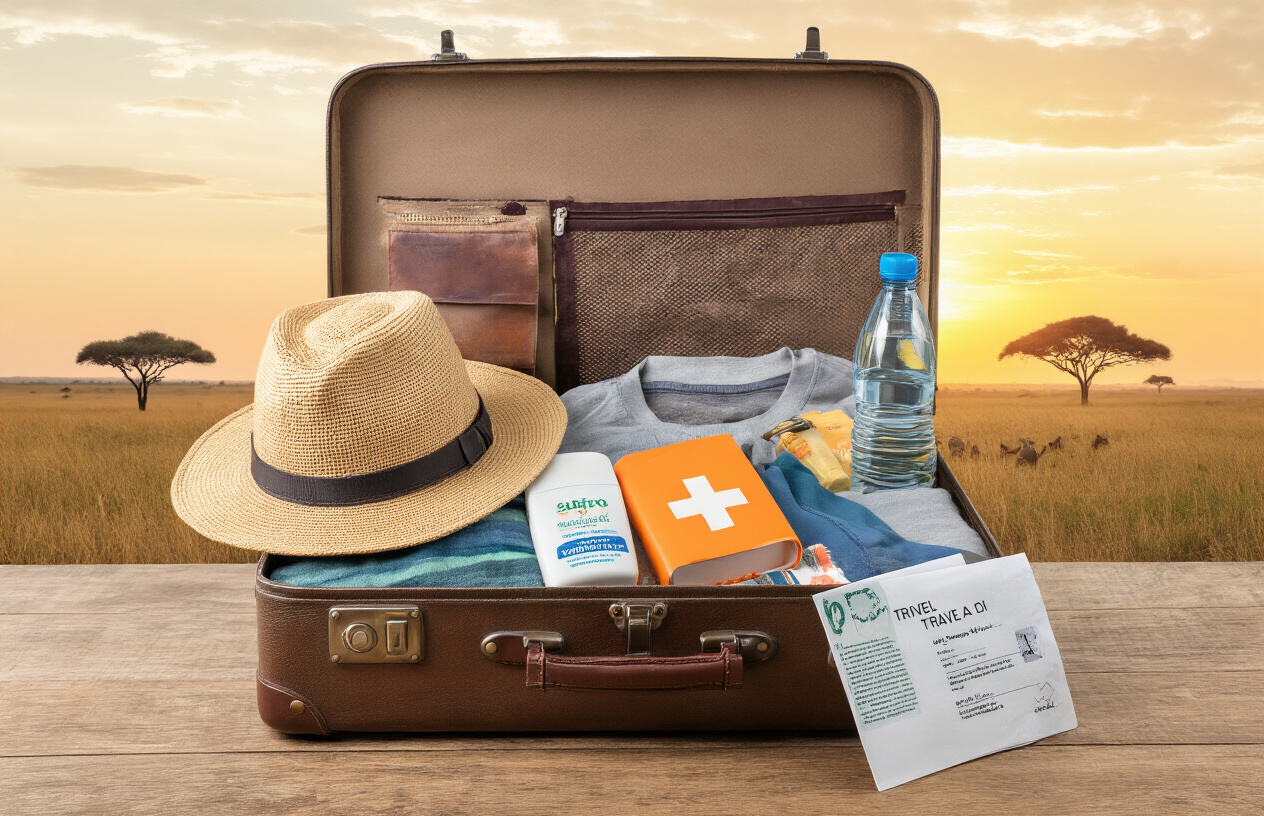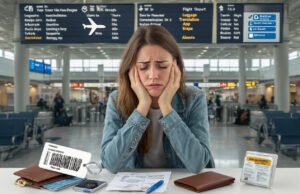Planning a trip to Africa? Discover the ultimate packing checklist with 25 essential items for Africa. It includes documents and medical supplies. There is also clothing and tech gear. Guarantee a safe, comfortable, and culturally respectful journey with our expert tips.
Here are the 25 Essential Items for Africa you must have for your travels. When packing for Africa, consider the 25 Essential Items for Africa that cater to various environments.
Perfect for safaris, city exploration, or beach getaways! Africa is a continent of unparalleled diversity, from the vast savannas of the Serengeti to the bustling markets of Marrakech.
This guide provides a detailed overview of the 25 essential items for a successful African trip. It covers documentation and health supplies. You’ll also find advice on clothing, tech, and cultural considerations. Whether you’re embarking on a safari, exploring urban hubs, or relaxing on coastal beaches,
Table of Contents
Essential Documents and Money Matters
Make sure to include these 25 Essential Items for Africa in your packing list.

A. Passport, Visa, and Travel Insurance
Your passport is your lifeline. Make sure it has six months’ validity beyond your return date, as many African countries enforce this rule strictly. Visa requirements vary—countries like Tanzania and Kenya offer visas on arrival, while Ethiopia and Nigeria need advance applications. Check each country’s embassy website for specifics.Travel insurance is non-negotiable. Comprehensive coverage should include:
- Medical emergencies
- Evacuation (costs can exceed $50,000)
- Trip cancellation
- Lost luggage
Consider providers like World Nomads for tailored travel insurance
Each of the 25 Essential Items for Africa plays a crucial role in your safety and enjoyment.
Don’t forget the 25 Essential Items for Africa as you finalize your packing.
B. Cash and Cards
US dollars are widely accepted. They must be crisp, post-2009 bills in high denominations ($50s, $100s) for better exchange rates. Carry two cards (Visa and Mastercard) and notify your bank of travel plans to avoid freezes. Keep a $200-300 cash stash hidden for emergencies, especially in rural areas where ATMs are scarce.
C. Emergency Contacts and Digital Copies
Create a digital and physical emergency folder with:
- Embassy contacts
- Local emergency numbers
- Hotel and transportation details
- Insurance policy information
Store copies in a secure cloud like Google Drive and email them to a trusted contact.
D. Medical Documentation
Pack an international vaccination certificate (yellow fever is mandatory for many countries). Include:
- Prescription medications in original packaging
- Doctor’s notes for medications
- Allergy and blood type information
These prevent border issues and guarantee proper medical care in emergencies.
To make the most of your trip, remember the 25 Essential Items for Africa you need to take.
Health and Medical Supplies

A. Prescription Medications and Basic First Aid
While traveling across Africa, you should not run out of medicine. Pack double the medication you need in original containers. A compact first aid kit should include:
- Bandages
- Antiseptic wipes
- Pain relievers (ibuprofen, acetaminophen)
- Antibiotic ointment
- Tweezers
- Medical tape
- Hydrocortisone cream
Add rehydration salts for hydration in hot climates.
B. Malaria Prevention and Treatment
Malaria is a serious risk. Consult a travel doctor for antimalarial prescriptions suited to your destination. Pack:
- Emergency standby treatment
- Mosquito diagnostic kits (for extended stays)
Use CDC’s malaria map to check risk areas.
C. Stomach Remedies for Food Adjustments
New foods and water can upset your stomach. Pack:
- Loperamide (Imodium)
- Bismuth subsalicylate (Pepto-Bismol)
- Probiotics
- Ginger chews
- Electrolyte packets
The local food is amazing, but your stomach will disagree at first. Better safe than sprinting for bathrooms that do not exist where you’re going.
D. Insect Repellents and Bite Treatment
Bugs in Africa aren’t playing around. Bring:
- DEET repellent (30-50% concentration)
- Permethrin spray for clothing and gear
- Antihistamine cream for bites
- Oral antihistamines
- Insect bite relief pen/stick
Apply repellent obsessively, especially at dawn and dusk. Those tiny mosquitoes can cause major prob
E. Sunscreen and After-Sun Care
The African sun is brutal, even on cloudy days. Pack:
- Broad-spectrum SPF 50+ sunscreen
- Lip balm with SPF
- Aloe vera gel (100% pure if possible)
- Wide-brimmed hat
- Zinc oxide for extreme sun exposure
Reapply sunscreen every two hours and after swimming. Sunburn can ruin your trip faster than anything else. The equatorial sun doesn’t mess around – you’ll burn faster than you think.
Clothing for Various African Climates

A. Lightweight, Breathable Fabrics for Hot Weather
Choose cotton, linen, or moisture-wicking fabrics for hot weather. Light colors mirror heat, keeping you cool. Avoid synthetics that trap heat.
Pro tip: Simple physics that makes a huge difference when you’re standing in the Serengeti with zero shade.
B. Layering Options for Cooler Evenings
Deserts and mountains get chilly at night. Pack a light fleece jacket, hoodie, and a lightweight scarf for versatility.
A lightweight scarf is the multi-tool of travel clothing. You can use it as a neck warmer. It can also serve as a head covering. On long bus rides, it works as a makeshift pillow.
C. Safari-Appropriate Neutrals
Wear khaki, olive, beige, or brown to blend into the environment and avoid attracting insects. Bright colors can scare wildlife.
D. Rain Protection for Wet Seasons
A packable rain jacket and waterproof bags for electronics are essential for sudden downpours, especially during wet seasons.
Tech Essentials and Power Solutions

Camera Equipment for Wildlife Photography
Ever tried to snap a cheetah with your smartphone? Yeah, good luck with that. Africa’s wildlife deserves better than blurry, distant shots.
Pack a DSLR or mirrorless camera with a decent zoom lens (at least 300mm). The Nikon P1000 with its ridiculous 3000mm zoom is overkill but man, the elephant nostril shots you’ll get!
Don’t forget:
- Extra memory cards (you’ll take WAY more photos than you think)
- Spare batteries (charging opportunities can be sparse)
- Lens cleaning kit (dust is everywhere)
- A sturdy camera bag that’s dust and water-resistant
Pro tip: A beanbag camera rest works better than a tripod in safari vehicles. Just fill it with beans or rice when you arrive.
Universal Travel Adapters
Africa has about as many plug types as it has countries. South Africa alone uses a unique three-pronged outlet that looks like it was designed specifically to frustrate travelers.
Grab a quality universal adapter with multiple USB ports. The ones with built-in surge protection are worth the extra few bucks – power fluctuations are common.
Portable Power Banks
Power outages in Africa aren’t a possibility – they’re a guarantee. Your fancy safari lodge can run on generators, but they don’t always work 24/7.
Get a robust 20,000+ mAh power bank. The kind that can charge your phone 5+ times. Even better, invest in a solar-compatible one. That African sun is good for something besides sunburns.
Phone Apps and Offline Maps
Cell service in the Serengeti? Cute thought.
Offline Apps and Maps Download offline tools like:
- Maps.me
- iNaturalist
- XE Currency
- Language apps Duolingo
Safari and Outdoor Gear

Quality Binoculars for Wildlife Viewing
Safari without binoculars? That’s like going to a concert and forgetting your tickets.
You’ll want a decent pair with at least 8×42 magnification. This gives you the perfect balance between zoom power and stability. Any higher, and every heartbeat turns your vision into a shaky mess.
Opt for waterproof models (morning dew and surprise rain showers happen) with rubber armor coating. Trust me, when you’re scrambling to spot that elusive leopard in a tree, you’ll be grateful. You’ll thank yourself for investing in binoculars that can handle being bumped around.
Don’t break the bank though. Mid-range options like Nikon Monarchs or Vortex Diamondbacks give amazing clarity without the heart-stopping price tag of premium brands.
Comfortable Backpack or Daypack
Your daypack is basically your survival kit on wheels (minus the wheels).
Look for something in the 20-30L range with padded shoulder straps. Your shoulders will be grateful after a full day of game drives.
Multiple compartments aren’t just nice-to-have, they’re essential. You need quick access to your camera when that lion pride suddenly appears. At the same time, keep your snacks, water, and extra layers organized.
Water-resistant material is non-negotiable. African weather can turn on a dime, and nothing ruins a camera faster than unexpected rain.
Wide-Brimmed Hat and Sunglasses
The African sun doesn’t mess around. It’s brutally direct, especially near the equator.
A good safari hat needs at least a 3-inch brim all around to protect your face, ears, and neck. Skip the fashion statements and go for functionality – something that packs flat but springs back to shape.
For sunglasses, polarized lenses are worth every penny. They cut glare from water and make spotting animals easier. Plus, they protect your eyes from harmful UV rays. These rays are significantly stronger in Africa than what you’re probably used to.
Reusable Water Bottle and Purification Options
Dehydration is the silent safari-killer. You need to drink way more water than you think.
Bring an insulated bottle that keeps water cool for hours – I recommend something in the 32-40oz range. The Hydroflask and YETI options are practically indestructible.
Don’t assume clean water will always be available. Pack purification tablets or a filtration system like LifeStraw. The SteriPen UV purifiers are also incredibly effective and quick to use.
Some lodges offer filtered water for guests to refill bottles, but never assume. Being capable of making safe drinking water anywhere gives you serious peace of mind.
Footwear for African Adventures

Sturdy Hiking Boots for Safaris
You’re headed to Africa and packing the wrong shoes? Big mistake. Huge.
Sturdy hiking boots aren’t just a suggestion for safaris—they’re non-negotiable. When you’re trekking through Kruger or the Serengeti, you’ll be thankful. This gratitude will be for having boots with proper ankle support and thick soles.
Look for waterproof options that can handle sudden downpours and morning dew. Your feet will stay dry when walking through wet grass during early morning game drives.
And those thorns? African acacia thorns can pierce through regular sneakers like they’re made of paper. Good hiking boots will save you from a painful encounter.
Comfortable Walking Shoes for City Exploration
Hitting up Cape Town, Nairobi, or Marrakech? Don’t wear your clunky hiking boots around town.
Pack a pair of breathable walking shoes. Your feet will thank you after a day of market browsing and street food sampling. Think lightweight trainers or walking shoes that won’t take up too much precious luggage space.
The streets can be uneven in many African cities, so shoes with good support are a must. Skip the fashion-first options and go for utility.
Sandals for Beach and Casual Wear
The African coast boasts some of the world’s most gorgeous beaches, from Zanzibar to Mozambique.
Sturdy sandals (not flimsy flip-flops) pull double duty – perfect for beach days and casual evenings. Get ones that can handle being wet and won’t give you blisters in the heat.
Water shoes are worth considering too, especially for rocky beaches or if you’re planning to snorkel. They protect your feet from sharp coral and sea urchins that are lurking in those crystal-clear waters.
Sleep and Comfort Items

A. Travel Pillow and Eye Mask
Ever tried sleeping on a bumpy safari vehicle or noisy hostel? Nightmare, right? A quality travel pillow can make a huge difference. It can mean arriving at your destination refreshed. Otherwise, you end up with a neck that feels like it went through a boxing match.
Go for memory foam or inflatable options – they pack down tiny but deliver major comfort when you need it. And those eye masks? Absolute game-changers in Africa. When you’re camping under the stars, the bright African sunshine will wake you up at 5 AM. It’s the same when staying in accommodations with thin curtains. You’ll need protection to stay asleep.
B. Light Sleeping Bag or Liner
African nights can get surprisingly chilly, especially in desert regions or at higher altitudes. A lightweight sleeping bag or silk liner adds warmth. It also serves as your personal cocoon of cleanliness when accommodation standards vary.
Silk liners are perfect. They weigh next to nothing. They protect against questionable bedding. They add just enough warmth without making you sweat. Plus, they dry super fast if you need to wash them.
C. Earplugs for Noisy Accommodations
The sounds of Africa are magical… until it’s 3 AM and you’re wide awake listening to frogs, insects, or the party at the bar next door. Pack good foam or silicone earplugs – not the cheap airplane ones that fall out.
Trust me, when you’re trying to sleep before a 5 AM game drive, you’ll thank yourself for bringing them.
D. Mosquito Net (If Not Provided)
Mosquitoes in Africa aren’t just annoying – they can carry malaria and other diseases. Many lodges offer nets, but budget accommodations do not, or theirs have holes.
A portable mosquito net that can hang from a single point is worth its weight in gold. Look for nets pre-treated with permethrin for extra protection. The peace of mind alone helps you sleep better. Sleeping without the constant buzzing in your ear is priceless.
Toiletries and Personal Care

A. Biodegradable Soap and Shampoo
Bringing biodegradable soap and shampoo isn’t just an eco-friendly choice—it’s practically mandatory for many African adventures. Regular soaps contain harmful chemicals. These chemicals wreak havoc on delicate ecosystems, especially if you’re bathing in rivers or lakes during your safari or trek.
I learned this the hard way when camping near the Okavango Delta. The guide almost grabbed my regular shower gel. He explained how those chemicals would linger in the water for years.
Use Dr. Bronner’s biodegradable soap to protect ecosystems during outdoor bathing
B. Quick-Dry Travel Towel
Forget about packing that fluffy bath towel. It’ll never dry in humid African climates and will soon smell like something died in your backpack.
A microfiber towel dries fast and saves space.
I once spent two weeks traveling through Tanzania with a regular cotton towel. Big mistake. It was perpetually damp, added pounds to my pack, and eventually I just abandoned it.
C. Toilet Paper and Hand Sanitizer
The truth? Toilet paper is like gold in many parts of Africa. Many restrooms—even in some hotels—don’t offer it.
Carry a roll (remove the cardboard tube to save space) in a waterproof bag. For day trips, stash a small amount in a ziplock bag.
Hand sanitizer with at least 60% alcohol content should be practically glued to your hand. You’ll use it constantly—before eating street food, after handling money, after using public transportation.
D. Feminine Hygiene Products (Limited Availability)
Women, listen up. Finding the brands and types of feminine products you’re used to can be next to impossible in rural areas. It is also challenging even in major African cities.
Pack more than you think you’ll need. Consider bringing a menstrual cup—it’s reusable, eco-friendly, and takes up minimal space. If you use tampons, bring your own, as they’re harder to find than pads in many places.
My friend had to travel four hours to find tampons when we were volunteering in a small Ugandan community. Don’t put yourself in that position.
Cultural Respect and Safety

Modest Clothing Options for Conservative Areas
Africa’s diverse cultures mean what flies in Cape Town can raise eyebrows in Cairo. Packing modest clothing isn’t just about respect—it’s practical travel sense.
For women, bring:
- Lightweight scarves (cover shoulders, head, or wrap as a skirt in a pinch)
- Maxi skirts or loose pants that breathe in the heat
- T-shirts that cover shoulders and collarbone
- Long-sleeved button-ups (roll up sleeves when appropriate)
For men:
- Pants that convert to shorts (zip-offs are travel gold)
- Shirts with collars for more formal settings
- Long shorts that hit below the knee
Nobody’s saying dress like you’re attending a funeral. Just skip the booty shorts and tank tops when visiting rural villages or religious sites.
Small Gifts for Local Communities
Forget the candy and pens. Those create dependency and expectations for the next traveler.
Smart gifts that actually help:
- Photos you’ve taken (bring a portable printer)
- Reusable market bags
- Quality school supplies for teachers (not random handouts)
- Small solar-powered items
The best gift? Hiring local guides, eating at family restaurants, and buying directly from artisans.
Money Belt or Security Pouch
Getting robbed sucks anywhere, but it’s extra painful when you’re 5,000 miles from home.
Options that actually work:
- Under-clothing money belts (sweaty but secure)
- Bra pouches for emergency cash and cards
- Neck pouches (hide under your shirt)
- Anti-theft crossbody bags with locking zippers
Split your cash and cards between spots. Keep just enough for the day in your regular wallet.
Basic Phrase Book or Language App
Nothing breaks down barriers faster than butchering a local greeting with a huge smile.
Learn basic phrases with Google Translate or Memrise to connect with locals.
Learn these game-changers in any language:
- “Hello/Thank you”
- “Beautiful!” (for complimenting crafts)
- “Delicious!” (for food)
- “May I take your photo?”

FAQs About Packing for Africa
What is the most forgotten item for an Africa trip?
A portable door lock or mosquito net. Rangers often note travelers regret skipping these for safety and comfort in remote accommodations.
How much cash should I bring to Africa?
Carry $200-300 in crisp, post-2009 US dollars for emergencies, plus two credit cards. Split cash across secure locations like a money belt.
What clothing is best for African safaris?
Neutral colors (khaki, olive, beige) in breathable fabrics like cotton or linen. Avoid bright colors to blend with the environment.
Do I need malaria medication for Africa?
Yes, for most regions. Consult a travel doctor for destination-specific antimalarials and pack DEET repellent and permethrin-treated clothing.
What type of shoes are best for Africa?
Sturdy, waterproof hiking boots for safaris, lightweight trainers for cities, and durable sandals for beaches.
How do I respect local cultures in Africa?
Wear modest clothing (covering shoulders and knees), learn basic local phrases, and offer thoughtful gifts like photos or school supplies.
What tech gear is essential for Africa?
A DSLR camera, universal adapter, 20,000+ mAh power bank, and offline apps like Maps.me or XE Currency.
Is travel insurance necessary for Africa?
Absolutely. Comprehensive insurance covering medical emergencies, evacuation, and trip cancellation is critical due to variable medical facilities.
Can I find toiletries in Africa?
Basic toiletries are available in cities, but rural areas have limited stock. Pack biodegradable soap, quick-dry towels, and extra feminine products.
How do I stay hydrated in Africa?
Use a 32-40oz insulated bottle and carry purification tablets or a LifeStraw for safe drinking water in remote areas.





Pingback: Conquer 10 Common Travel Problems: Your Guide To Joyful Journeys